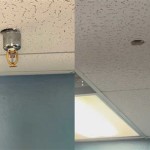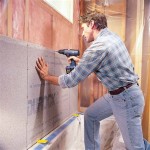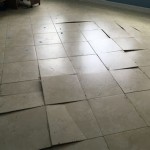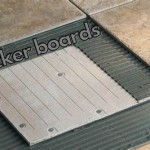How to Lay Flooring Over Asbestos Tile Safely and Effectively
Many older homes contain asbestos floor tiles, often 9x9 inch or 12x12 inch squares. While these tiles, when intact and undisturbed, pose minimal risk, their removal can release harmful asbestos fibers into the air. Covering asbestos tile with a new flooring layer is often a safer, more cost-effective, and less disruptive alternative to asbestos abatement. This practice, known as encapsulation, involves sealing the existing asbestos tiles to prevent fiber release. However, it is crucial to understand the proper procedures and safety precautions before undertaking such a project.
This article will provide a comprehensive guide on how to safely and effectively lay new flooring over existing asbestos tile. It will cover essential preparation steps, appropriate flooring options, installation techniques, and crucial safety considerations. Adherence to these guidelines minimizes the risk of asbestos exposure while achieving a successful flooring upgrade.
Key Point 1: Understanding the Risks and Regulations
Before proceeding with any work involving potential asbestos-containing materials (ACM), it's vital to fully understand the associated risks. Asbestos is a naturally occurring mineral that was widely used in building materials due to its heat resistance, strength, and insulating properties. However, when asbestos fibers are released into the air and inhaled, they can cause serious health problems, including asbestosis, lung cancer, and mesothelioma.
It is important to note that undisturbed asbestos tiles generally pose a low risk. The danger arises when the tiles are damaged, broken, or sanded, which can release asbestos fibers. The goal of laying new flooring over asbestos tiles is to encapsulate them, preventing any disturbance and fiber release. This approach avoids the significant costs, complexities, and potential risks associated with asbestos removal.
Furthermore, regulations regarding asbestos handling and encapsulation vary depending on location. Some jurisdictions may require professional assessment or notification before any work is performed on ACM. It is imperative to research and comply with all applicable federal, state, and local regulations. Contacting local health departments or environmental agencies can provide clarity on these requirements. Failure to comply with regulations can result in significant fines and legal consequences.
Even if regulations do not mandate professional involvement, it is strongly recommended to consult with an asbestos abatement professional or certified inspector. They can assess the condition of the existing tiles, identify any potential hazards, and provide guidance on the safest and most appropriate encapsulation methods. This initial assessment can help to prevent unforeseen problems and ensure a successful outcome.
If the tiles are significantly damaged, deteriorating, or if there are signs of asbestos fiber release (e.g., visible dust or debris), encapsulation may not be the best option. In such cases, professional asbestos removal may be necessary. Attempting to cover severely damaged tiles could exacerbate the problem and increase the risk of exposure.
Key Point 2: Preparing the Existing Asbestos Tile Floor
Proper preparation is essential for the successful installation of new flooring over asbestos tiles. This involves cleaning, leveling, and sealing the existing surface to ensure a stable and safe foundation. The quality of the preparation directly impacts the longevity and appearance of the new flooring.
The first step is to thoroughly clean the existing asbestos tile floor. Use a HEPA (High-Efficiency Particulate Air) vacuum cleaner to remove all loose debris, dust, and dirt. A HEPA vacuum is crucial because it filters out microscopic particles, including asbestos fibers, preventing them from being released into the air. Avoid using a regular vacuum cleaner, as it may redistribute asbestos fibers.
After vacuuming, clean the floor with a mild detergent and warm water. Avoid using harsh chemicals or abrasive cleaners, as they could damage the tiles and potentially release asbestos fibers. Gently scrub the floor with a soft brush or mop, ensuring that all dirt and grime are removed. Rinse the floor thoroughly with clean water and allow it to dry completely. This cleaning process helps to create a clean surface for subsequent sealing and leveling.
Next, inspect the floor for any loose, cracked, or damaged tiles. These must be repaired or secured before proceeding. Loose tiles can be re-adhered using a latex-based tile adhesive. Apply the adhesive sparingly to the back of the tile and press it firmly into place. For cracked tiles, consider using a flexible patching compound designed for flooring. Fill the cracks with the compound and smooth it out to create a level surface. Allow the adhesive and patching compound to dry completely according to the manufacturer's instructions.
Leveling the floor is a critical step in ensuring a smooth and even surface for the new flooring. Unevenness in the existing asbestos tile floor can cause problems with the new flooring, such as warping, cracking, or instability. Use a self-leveling underlayment to create a perfectly level surface. Follow the manufacturer's instructions carefully when mixing and applying the underlayment. Pour the mixture evenly over the floor and allow it to spread and self-level. Use a spiked roller to remove any air bubbles. Allow the underlayment to dry completely before proceeding to the next step. The drying time can vary depending on the product and environmental conditions.
Finally, seal the prepared asbestos tile floor with an appropriate sealant. This creates a barrier that encapsulates the asbestos fibers and prevents them from being released. Choose a sealant specifically designed for flooring and compatible with the chosen flooring type. Apply the sealant according to the manufacturer's instructions, ensuring that all tiles and seams are thoroughly covered. Allow the sealant to dry completely before installing the new flooring. This sealing step is crucial for long-term safety and prevents the migration of asbestos fibers.
Key Point 3: Choosing the Right Flooring and Installation Techniques
Selecting the appropriate flooring material and employing proper installation techniques are essential for a successful encapsulation project. Not all flooring types are suitable for installation over asbestos tiles. The chosen material must be durable, stable, and capable of providing a long-lasting barrier against asbestos fiber release. The installation method should minimize any disturbance to the existing tiles.
Several flooring options are well-suited for installation over asbestos tiles. These include sheet vinyl, luxury vinyl tile (LVT), laminate flooring, and engineered hardwood. Sheet vinyl is a popular choice because it is seamless, waterproof, and easy to install. LVT offers a more realistic appearance and greater durability than sheet vinyl. Laminate flooring is a cost-effective option that provides a wood-like appearance. Engineered hardwood is a more expensive option that offers a luxurious look and feel. Solid hardwood is generally not recommended, as it requires nailing or gluing, which could disturb the asbestos tiles.
The preferred installation method is a floating floor installation. This method involves interlocking the flooring planks or tiles together without adhering them directly to the existing floor. Floating floors are easy to install, require minimal preparation, and do not disturb the asbestos tiles. They also allow for expansion and contraction of the flooring material, preventing warping or cracking.
When installing a floating floor, it is essential to use an underlayment. The underlayment provides cushioning, reduces noise transmission, and helps to level out any minor imperfections in the subfloor. Choose an underlayment specifically designed for the chosen flooring type and follow the manufacturer's instructions for installation. Ensure that the underlayment is properly sealed at the seams to prevent moisture from penetrating to the asbestos tiles.
If gluing the new flooring is absolutely necessary, use a low-VOC (Volatile Organic Compound) adhesive specifically designed for resilient flooring. Apply the adhesive sparingly and evenly to the prepared subfloor. Follow the manufacturer's instructions for application and drying time. Avoid using adhesives that contain strong solvents, as they could damage the asbestos tiles or release asbestos fibers. Exercise extreme caution to minimize any disturbance to the existing tiles during the gluing process.
During the installation process, continue to use a HEPA vacuum cleaner to remove any dust or debris that may be generated. Wear appropriate personal protective equipment (PPE), including a respirator with a HEPA filter, disposable coveralls, and gloves. This protects against potential asbestos exposure. Dispose of all waste materials properly in sealed plastic bags labeled as containing asbestos. Contact local waste disposal authorities for guidance on proper disposal methods.
Carefully cut the new flooring to fit around pipes, doorways, and other obstacles. Use a sharp utility knife or a power saw with a dust collection system to minimize dust generation. Seal all edges of the new flooring with caulk or trim to prevent moisture from penetrating to the asbestos tiles. This helps to protect the encapsulated asbestos tiles from water damage and prolong the life of the new flooring.
After the installation is complete, thoroughly clean the area with a HEPA vacuum cleaner. Inspect the floor for any gaps or imperfections and address them promptly. Regularly maintain the new flooring according to the manufacturer's instructions. This will help to ensure its longevity and protect the encapsulated asbestos tiles for years to come.
By following these steps carefully, homeowners can safely and effectively lay new flooring over existing asbestos tiles, creating a beautiful and safe living environment. While this method is generally safer than asbestos removal, it's always crucial to prioritize safety and consult with professionals when in doubt.

How To Install Hardwood Flooring Over Asbestos Tiles 123

Install Hardwood Floor Over Asbestos Tile Without A Floating Subfloor Ruth Chafin Interior Design

Installing Laminate Flooring Over Asbestos Tiles The Money Pit

Installing Hardwood Over Asbestos Tiles Homeadvisor

How To Install Tile Over Asbestos Ehow

Flooring That Can Be Installed Over Asbestos Tile

Can I Cover Asbestos Floor Tiles With Concrete

Can I Put A New Floor Over Asbestos Tiles Branch Environmental

What Flooring Can You Put Over Asbestos Tile Hunker

What Flooring Should I Use Over Old Asbestos Tiles
Related Posts








